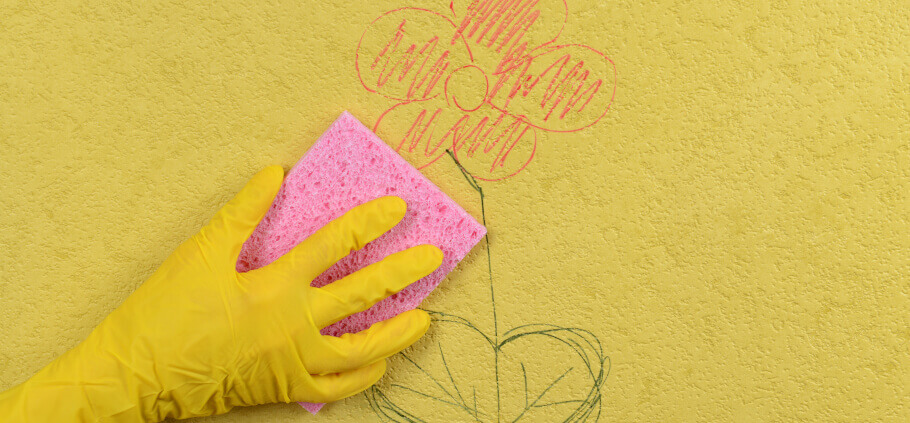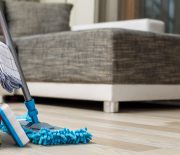Last update: 6 months ago

Wallpaper comes in a wide variety of designs and is relatively easy to install. However, even the most durable material can fade and even get damaged over time, especially with a lack of good cleaning and maintenance. In addition to dust and food stains, footprints and crayon marks can also compromise the otherwise flawless wallpaper’s look. And the longer they are left onto the material, the harder their removal will be.
Not all wallpapers are made equal, though. And this means homeowners are faced with a challenging job – how to clean their wallpaper without damaging it? Well, we have a few suggestions and cleaning hacks to share, so let’s get down to business!
Are wallpapers washable?
Some types of wallpaper are, in fact, washable. Solid vinyl and fibreglass, to be exact. These two are often preferred choices not just for their water resistance and washable qualities but also because of their durability. Solid vinyl wallpaper can serve you for up to 20 years, so it’s definitely an investment to consider, especially for areas of the house like the kitchen and bathroom, which get quickly dirty and where humidity runs high.
According to professional cleaners, most synthetic materials can be maintained with wet-cleaning methods, and one of the reasons is their shiny protective coating. On the other hand, wallpapers made of natural materials, such as bamboo, fabric, plants and the likes, can be damaged by moisture. The latter applies to wallpapers that consist of both natural and synthetic materials, too.
The best way to be sure is to inspect the label of your wallpaper, where composition and washable/non-washable qualities should be listed. If you can see the manufacturer’s name, you can also look for information online.
The best way to clean wallpapers
Once you determine the type of wallpaper you are about to clean, next comes the time for preparation and the actual work. No worries, though, we promise that the process is straightforward, and we will walk you through it step-by-step below. The only thing that may slow you down is the removal of different stains and cleaning of more specific wallpaper material, such as the textured type.
What you will need:
- Duster or vacuum cleaner with brush application
- Rubber gloves
- Large container
- Clean soft sponge
- Microfibre cloth
- Mild colourless soap
- White vinegar
- Warm and cold water
- Gum eraser
- Dough
How to clean washable wallpaper
Washable wallpapers may appear easier to clean, but there are still some things to consider and be on the lookout for.
- Dust from top to bottom – It’s essential that you begin by dusting the wallpaper well. Otherwise, you’ll end up with a big mess once you start washing with water. The quicker and easier way to eliminate all collected dust is to use a vacuum cleaner with a brush attachment. You can also use a duster if you’d like, but the vacuum cleaner is the more effective method. Start at the top and work your way down, so that you can collect any fallen dust from the floor in the end.
- Mix the soap and water – There’s no need to use abrasive or aggressive chemical cleaners since the first can scratch the wallpaper’s protective layer, while chemical cleaners could cause a reaction and leave discolouration spots. Soap and plain lukewarm water will be more than enough to make your wallpaper’s surface shiny and clean again. Mix 1-2 tbsp of soap into 2l of water. If you notice that the solution gets too soapy, add more water.
- Wash every part of the wallpaper – We advise you to vertically divide the wall into two sections and work them one at a time. You need to just dampen the surface, not make it soaking wet. Do not work on stains at this point, as you can focus on them at a later point.
- Dry the surface with a clean microfibre cloth – It is best to dry the wallpaper surface with a cloth immediately after the washing. This way, you’ll collect the remaining moisture and grime and prevent streaks from appearing.
- Treat the stains – You can use vinegar to clean wallpaper, but limit yourself to treating just the washable kinds. White vinegar can be of great help for eliminating greasy food, mould or brown spots. It has many great properties, two of which are killing bacteria/fungus and breaking down grease. We dive into different stain treatments further down.
How to clean non-washable wallpaper
These types of wallpaper require a little bit more care and attention when it comes to cleaning, as they cannot undergo a wet cleaning. Still, this is a task that you can handle.
- Remove the dust – Clean the dust off your wallpaper with the vacuum cleaner using the brush extension. Keep in mind that textured materials along with velvet or other fabric wallpapers can be easily damaged. So, do not press hard with the brush when trying to extract the dust.
- Inspect the wallpaper – Once the dust is removed, you can easily look for stains. Keep those in mind, so you can treat them later.
- Lift stains and spots – This may prove a bit more challenging, as non-washable wallpapers cannot be treated with spray cleaners or any other type of liquid cleaner. There are two dry cleaning alternatives that you can try. One of them is to treat the area with a dry cleaning sponge. It can remove soot, smoke and other debris. It is reusable and completely safe to use on non-washable materials. The second alternative is to clean your wallpaper with dough or another putty-like dry cleaning product. It may sound unusual, but did you know that play-dough was originally developed precisely for cleaning wallpaper? Who knew! As it turns out, this is a recommended option for delicate wallpapers, as it does not pose a risk for the material and all you have to do is roll the dough over the surface to get that nasty grime off.
Removing stains from wallpaper
And now, let’s focus on the wallpaper stain removal process in greater detail, being the most challenging part of the job.
Fingerprints and food grease
You may not even notice the fingerprints until you inspect the wallpaper closer. Once you do, though, you can try removing them from the coated and smooth surface with a gum eraser.
If that does not help or there are just too many, the vinegar and water combo can tackle both handprints and grease-rich food stains from vinyl and other washable wallpaper. After all, vinegar breaks down grease, remember?
When it comes to more delicate materials, heat from an iron or a blow dryer can help extract the stain safely. Just to be on the safe side, we would recommend the blow dryer method for several reasons. On one hand, it is easier to regulate the amount of heat you are directing at the wallpaper, and, on the other, there is no risk of ending up with a nasty iron-shaped burn mark on your wall.
You can try melting the stain with the blow dryer and wiping it with a paper towel. If that’s not enough or you are set on trying the iron method, then place a cloth onto the stain and heat it up with the iron. This way the oily substance can be transferred onto the cloth.
Mould and dark spots
If you see dark spots on the wallpaper, these are most likely caused by mould or water. Neither should be ignored, so you need to act before they spread.
You will likely need experts to locate any leakages in the house and fix them for good. As for the mould, in some cases, the vinegar plus water could be enough to kill the mould and also tackle some dark spots that are caused by cigarette smoke. Again, this is best used on vinyl and fiberglass wallpapers that can be treated with liquid cleaners.
However, if you are facing black mould and there is a substantial build-up, a bleach and water solution will be more effective. Keep in mind, though, that bleach can whiten materials, which is why it should not be used on dark-coloured wallpapers. Also, start with a weak solution of just 1-2 tbsp of bleach diluted into 1l of water. Definitely test to see how it reacts on a less visible spot before you apply more of it.
Crayon
If your kids have decided to use the wallpaper as their drawing sheet, don’t be in a rush to panic. This is not the end of the world, and there is a way to fix it. While there are different cleaning solutions that you can test, probably the safest and most effective one remains using heat. This gives you a higher chance of lifting as much, if not all, of the crayon from the wallpaper without the need to scrub hard.
Again, you can use the iron or blow dryer method, mentioned above, to break down the stain and absorb it with a clean rag or paper towel.
Start by removing the excess substance gently from the wall with a plastic scraper. Proceed to melt the remaining crayon with the help of the blow dryer. Then, carefully wipe. Clean any visible leftover marks with soap and water, if your wallpaper allows it.
Dos and Dont’s of cleaning wallpaper
And now, a few essential wallpaper cleaning rules to remember that can get you satisfying results and save you from crucial mistakes and possible wallpaper replacement.
Dos
- Always inspect the wallpaper’s condition before you start cleaning. This can help you identify the material and also locate damage or stains that need to be taken care of.
- Speaking of identifying the material, always look for a label, brand or some other clues that may lead you to cleaning and maintenance recommendations for the specific product.
- Clean stains immediately, especially when it comes to food or colour-rich beverages like coffee or wine. Once they settle into the wallpaper, they will be very tough to lift.
- Use white vinegar, bleach and a soap and water combo to treat only washable and durable wallpapers.
- Dust your wallpaper at least once every three months. Deep clean and spot treat the surface minimum once a year. High-risk areas, such as the kitchen, bathroom and the kids’ room, can benefit from more frequent care.
Dont’s
- Never use abrasive products to clean wallpaper’s surfaces, regardless of whether it’s made of a washable or non-washable material.
- Don’t start cleaning wallpaper if you are not sure what the material is. You may damage it irreversibly.
- Don’t risk using water or water-based cleaners on a wallpaper that you know is delicate and non-washable. This may sound obvious, but sometimes, people decide to experiment anyway, and the result could be ugly.
- Speaking of experimentations, don’t forget to test every cleaning method you decide to use on a small and hidden spot of the wall before proceeding with the full cleaning.
Get the professionals to lift the stains off your wallpaper!
A Fantastic cleaner is at your disposal!








